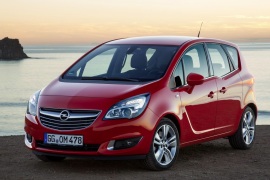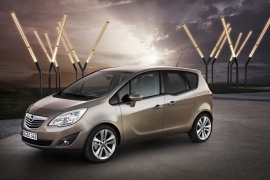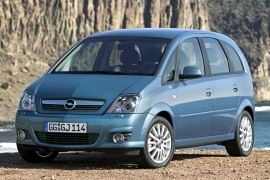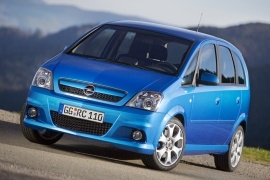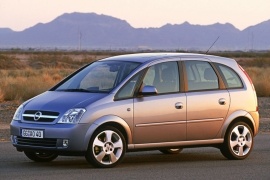OPEL Meriva Models/Series Timeline, Specifications & Photos
First production year: 2003
Engines: Diesel, Gasoline, Natural gas
Body style: Van
Opel introduced the second generation of the Meriva in 2010 and it had to upgrade it in 2014 to meet the Euro 6 emission standards, which became mandatory in September same year.
Based on an extended platorm of the Corsa, the small-sized MPV proved that it could be a real alternative for larger family vehicles. In addition, the facelifted version of the Meriva boasted an elegant look and fuel efficient engines. Last but not least, the car's interior was vast, suitable for up to five passengers inside.
Along with the facelifted version, the 2014 Meriva came with an improved front fascia. Its redesigned headlights included LED daytime running lights. In addition, the grille lost the upper, fat, chromed slat and gained a slimmer one that looked more elegant. To ease ingress and egress to the car, the MPV sported rear-hinged rear doors, while the front ones were regular. Finally, at the back, it sported crisp-looking LED taillights.
Inside, the rear passengers could get in and out easier than in the vehicles with normal opening doors, and, on top of that, the car featured a grab handle on the B-pillar to help. Another advantage of the rear-hinged doors is the easy fitting of a child seat in the back and also strapping the safety belt on it. For the top version, the Meriva came equipped with a glass ceiling.
The new engine range featured three power versions for the 1.4-liter gasoline unit and a 1.6-liter turbocharged diesel with three versions for power. The standard transmission was a five- or six-speed manual, depending on the engine, while a 6-speed automatic was available at extra cost.
Introduced in 2010 at the Geneva Motor Show, the second generation of the small-sized minivan from Opel brought new ideas to a segment where there were not too many contenders.
General Motors didn't want to give up on the European minivans even though there was a small market for those vehicles. Moreover, Europe and UK were still weakened by the world financial crisis, and the economy was still recovering. But families needed cars, and the German automaker was keen to offer a wider variety of products, especially since it was in deep financial trouble. Thus, the second generation of the Meriva took the market by surprise thanks to its innovative ideas.
With an exterior that reminded customers that the Meriva was linked to the small-sized Corsa, the MPV featured big headlights and a grille with a chromed bar at the top. The bumper's lower grille formed, together with the side scoops, a smiling face. But the most unusual side of the car was its profile. The beltline went upwards until the B-pillars and then took a sudden downward step only to rise again until the C-pillars. Most importantly, the car featured rear-hinged back doors, easing the ingress and egress of the vehicle.
Inside, the high-mounted seats at the front allowed the designers to create more room for the rear passengers. It looks like this vehicle was mostly made for those seated in the back. The idea was to ease installing a child seat and its content. At the front, GM's design team separated the driver and the passenger area by installing a tall center console extended into the center stack between them.
This small-segment minivan offered a choice of gasoline or turbo-diesel powerplants underneath its hood. Unfortunately, only just a few versions were offered with an automatic transmission. Instead, most versions were paired with a five- or six-speed manual.
The small MPV based on the Opel Corsa was launched in 2003 and just two years later it received an update to keep its high-sell values up and running.
While the market started to shift away from the MPV segment, Opel dared to launch a minivan based on the same platform with their small-segment car. It was a huge success. The German car-maker succeeded to reach 500.000 units sold in their first three years of production. To keep the momentum, the car-maker introduced new engines and new aesthetic changes to the car.
The front fascia remained almost the same, but a chromed bar was installed on the upper side of the grille. The bumper received a wide air-intake and fog-lights integrated into the side air-intake. In the rear, the taillights were smoked, following the market trend for that detail.
Inside, there was a new design for the door panels, instrument cluster, and new upholstery materials. It featured a redesigned instrument graphics. The audio system received Bluetooth connectivity with mobile phones. To increase the thermal comfort, the Meriva featured a warm-air blower, that could heat the cabin right after starting the engine. It was very useful for the diesel engine versions.
The biggest changes were made for the engine compartment, where there were three new engines available: a 1.3-liter diesel, a 1.6-liter gasoline unit, and a 180 hp turbocharged 1.6-liter for the OPC version.
Opel tried something different and installed a punchy engine under the hood of its smallest MPV from the European market, the Meriva.
After two years on the market, the Meriva received a refresh in 2005 for the 2006 model-year. Thus, the carmaker adapted its small-sized minivan to the Euro4 emission standards and, moreover, added the OPC (Opel Performance Center) version, which was no slouch. Even though it didn't scream "performance" through all its parts, it didn't hide its performance-oriented nature.
Like the rest of the range, the 2005 Meriva OPC featured a body-colored slat on the grille instead of the older, chromed one used for the 2003 model-year. Unlike its siblings, though, this go-fast version also sported a different apron with a wide center air intake flanked by the foglights' scoops. From its sides, the 17" light-alloy wheels were unusually big for a car of this size. Moreover, they were wrapped in low-profile 205/45 tires. To complete the sporty image of this minivan, OPC added a roof spoiler on top of the tailgate and a chromed, trapezoidal exhaust.
Inside, the carmaker added a pair of bucket seats with high-bolstered areas that helped their occupants stay in place during high-speed cornering. The bench, on the other hand, was standard but with different colors than its non-OPC siblings. The driver enjoyed the revamped dashboard, with silver surrounded dials and the OPC lettering on the speedometer.
But the real magic happened under the hood, where a turbocharged, 1.6-liter powerplant carried over from the Corsa OPC boosted the minivan's performance. It was mated to a six-speed manual gearbox that sent the power to the front wheels. Moreover, the ground clearance was dropped by 0.4" (10 mm) at the front and 0.6" (15 mm) at the back, employing stiffer coilover suspension. Last but not least, the car sported disc brakes in all corners.
Opel showed the first generation of the small-sized MPV Meriva in 2002 and started to sell it in 2003, thus offering a vehicle big enough to fit a family of five but small enough to fit in tiny parking spots.
The small vehicle was based on the third generation of the Opel Corsa, and unlike its small-segment cousin, it featured an MPV stance with a taller greenhouse. It was meant to provide more interior room while still being lower priced than other minivans on the market. The result was surprisingly good, even though the market was already started to shift toward the SUV segment.
At the front, the little MPV showed a black grille adorned by a horizontal slat placed in the middle that sported Opel's badge. Its headlights were more vertical than longitudinal to create an impression of a taller vehicle. The hood was short and very steep, continued by the A-pillars and windshield. The car featured an unusual number of side windows, four, for such a small vehicle. Despite all the attention to the vehicle's shape, the carmaker didn't consider installing body-colored door handles or mirrors.
Inside, the Meriva offered high-mounted seats at the front with little side support. They were meant to provide easy access. Depending on the trim level and options, the carmaker installed a separate panel for the onboard computer in the middle of the dashboard, while the instrument cluster featured a four-dial layout for main information. The biggest advantage of the Meriva was the interior seat arrangement with a 60/40 split-folding rear bench seatback.
Under the hood, Opel offered a range of five engines, and two of them were turbo-diesels: one supplied by Fiat and the other by Isuzu.
